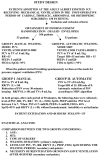Automatic versus manual pressure support reduction in the weaning of post-operative patients: a randomised controlled trial
- PMID: 19171056
- PMCID: PMC2688118
- DOI: 10.1186/cc7695
Automatic versus manual pressure support reduction in the weaning of post-operative patients: a randomised controlled trial
Abstract
Introduction: Reduction of automatic pressure support based on a target respiratory frequency or mandatory rate ventilation (MRV) is available in the Taema-Horus ventilator for the weaning process in the intensive care unit (ICU) setting. We hypothesised that MRV is as effective as manual weaning in post-operative ICU patients.
Methods: There were 106 patients selected in the post-operative period in a prospective, randomised, controlled protocol. When the patients arrived at the ICU after surgery, they were randomly assigned to either: traditional weaning, consisting of the manual reduction of pressure support every 30 minutes, keeping the respiratory rate/tidal volume (RR/TV) below 80 L until 5 to 7 cmH2O of pressure support ventilation (PSV); or automatic weaning, referring to MRV set with a respiratory frequency target of 15 breaths per minute (the ventilator automatically decreased the PSV level by 1 cmH2O every four respiratory cycles, if the patient's RR was less than 15 per minute). The primary endpoint of the study was the duration of the weaning process. Secondary endpoints were levels of pressure support, RR, TV (mL), RR/TV, positive end expiratory pressure levels, FiO2 and SpO2 required during the weaning process, the need for reintubation and the need for non-invasive ventilation in the 48 hours after extubation.
Results: In the intention to treat analysis there were no statistically significant differences between the 53 patients selected for each group regarding gender (p = 0.541), age (p = 0.585) and type of surgery (p = 0.172). Nineteen patients presented complications during the trial (4 in the PSV manual group and 15 in the MRV automatic group, p < 0.05). Nine patients in the automatic group did not adapt to the MRV mode. The mean +/- sd (standard deviation) duration of the weaning process was 221 +/- 192 for the manual group, and 271 +/- 369 minutes for the automatic group (p = 0.375). PSV levels were significantly higher in MRV compared with that of the PSV manual reduction (p < 0.05). Reintubation was not required in either group. Non-invasive ventilation was necessary for two patients, in the manual group after cardiac surgery (p = 0.51).
Conclusions: The duration of the automatic reduction of pressure support was similar to the manual one in the post-operative period in the ICU, but presented more complications, especially no adaptation to the MRV algorithm.
Trial registration number: ISRCTN37456640.
Figures







Comment in
-
Hippocrates is alive and weaning in Brazil.Crit Care. 2009;13(3):142. doi: 10.1186/cc7746. Epub 2009 May 18. Crit Care. 2009. PMID: 19519940 Free PMC article.
-
Comments on the study by Taniguchi and coworkers--proving Hippocrates is alive.Crit Care. 2009;13(4):415; author reply 415. doi: 10.1186/cc7957. Epub 2009 Aug 24. Crit Care. 2009. PMID: 19725941 Free PMC article. No abstract available.
References
-
- Esteban A, Alia I, Gordo F, Gordo F, Fernandez R, Solsona JF, Vallverdú I, Macias S, Allegue JM, Blanco J, CArriedo D, Léon M, De la Cal MA, Taboada F, Velasco JG, Palazón E, Carrizosa F, Tomás R, Suarez J, Goldwasser R. Extubation outcome after spontaneous breathing trial with T-peace or pressure support ventilation. Am J Respir Crit Care Med. 1997;156:459–465. - PubMed
-
- Brochard L, Rauss A, Benito S, Conti G, Mancebo J, Rekik N, Gasparetto A, Lemaire F. Comparison of three methods of gradual withdrawal from ventilatory support during weaning from mechanical ventilation. Am J Respr Crit Care Med. 1994;150:896–903. - PubMed
Publication types
MeSH terms
Associated data
LinkOut - more resources
Full Text Sources
Medical

